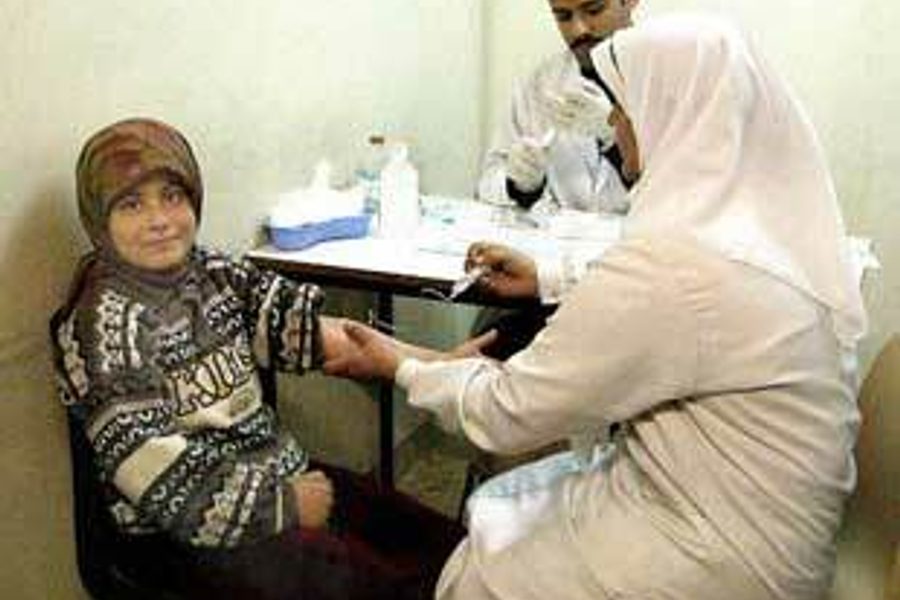
Zainab may be one of the 655,000 Iraqis who would be alive today if the Bush administration hadn’t launched its criminally conceived and executed war. Violence caused most of the excess deaths. But 54,000 people died from non-violent causes, such as heart disease, cancer and chronic illness. They were victims of a health care system eviscerated by mismanagement, ill-placed priorities, corruption and civil war.
The body count does not come from the U.S. government – which either does not bother to track, or won’t release, the Iraqi death toll – but from a survey by the Johns Hopkins Bloomberg School of Public Health and Baghdad’s Al Mustansiriya University, published in The Lancet.
Four years ago, just before the invasion, Zainab, age 10, sat small and dignified on a hard plastic chair in a featureless room in a Baghdad hospital. An IV dripped poison into her outstretched arm. Her leukemia was going into remission and she was pink-cheeked and doing well. Despite the shortage of medicine and care created by combined efforts of Saddam and U.S. sanctions, the medical system still functioned.
Pre-Gulf War Iraq was “believed to have the best health care system in the Mideast, so it had enough altitude that it could fall some and still survive,” says Gilbert Burnham, principal author of the Johns Hopkins survey.
Today, the country’s health care is in free fall. Most of the $1 billion that Washington transfused into the medical system has bled out through the open wounds of wars. Of the 34,000 doctors in Iraq at the time of the invasion, more than half are gone. Most fled the country; 2,000 were murdered.
“Senior doctors, especially surgeons, have left, and patients are seen by inexperienced physicians,” Dr. A., who requested anonymity, told In These Times. He left a Baghdad hospital in July to study in the United States.
Zainab may have finished treatment before the system collapsed around her and joined the 85 percent of childhood leukemia patients who survive. But this was March 2003, and, as you know, things would not be going well.
Today, patients like Zainab die daily from treatable illnesses and injuries. “That translates to more than 1,800 preventable deaths a year at [one Baghdad] hospital alone,” according to the Los Angeles Times, which quoted Iraqi physician Husam Abud: “f we get cases of cancer, we can’t treat them. They’ll probably end their days here.”
Making things worse, the Ministry of Health is controlled by Shia cleric Muqtada al-Sadr’s movement, “ignorant people who know nothing about medical science,” a doctor told InterPress Service (IPS) reporters Dahr Jamail and Ali Al-Fadhily.
More than ignorant, the clerics charged with protecting Iraqis’ health are part of sectarian militias with military, political and religious agendas. The “guards” they place in hospitals are an ominous presence. “They are wearing Ministry of Health uniforms,” says Dr. A., “but everyone knows they are part of Sadr’s militia. Of course, they are armed with machine guns.”
Everyone suffers, but Sunnis disproportionately. “We have no medications or blood serum supplies,” Tariq Hiali, a health official in mainly Sunni Baqubah told the Los Angeles Times. “The Ministry of Health is not providing us with medications and medical equipment; they consider [us] terrorists.”
Which means fair game in the escalating civil war. One doctor told IPS that ministry-controlled militiamen have “divert[ed] the ministry into a death squad headquarters.”
“Sunni patients are being murdered; some are dragged from their beds,” CBS News reported. “A man was bringing his murdered brother to the [hospital] morgue. They asked him if he knew who the killers were and he said ‘yes.’ They shot him right there,” said a medical worker.
Little wonder that physicians like Dr. A have joined Iraq’s 1.6 million post-invasion refugees.
Medical personnel remaining in Iraq have shown dedication and courage. They face shortages, death threats and kidnapping, as well as inadequate supplies that increase mortality, patient suffering and nosocomial infections.
And when militias dispense “security,” simply providing care is dangerous. “A doctor was attacked by [Ministry of Health] guards in Al Yarmook Hospital because he was preventing the guards from interfering in the medical care,” says Dr. A. “The doctors complained to the ministry that they cannot work in such an environment, and they held a one-day strike.”
Increasingly, the whole country is a fatally hostile environment, where people like Zainab die routinely from bad health care and worse policies. If she did not survive Iraq’s medical free fall, she was a casualty of war, as surely as the 600,000 felled by bullets and bombs.








